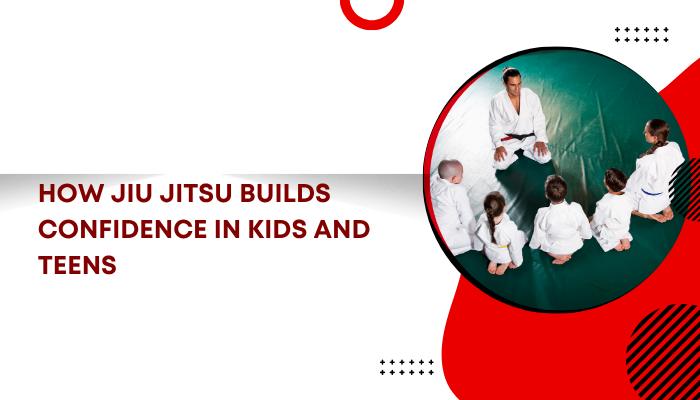How Jiu Jitsu Builds Confidence in Kids and Teens
You’ve probably heard people talk about martial arts as a great way to build confidence in kids- but when it...

You’ve probably heard people talk about martial arts as a great way to build confidence in kids- but when it comes to jiu jitsu, that benefit runs deeper than most parents realize.
As someone who’s spent years both training and watching younger students evolve on the mat, I’ve seen it firsthand: shy, anxious kids transforming into calm, assertive, and focused individuals. And no, it’s not magic. It’s the result of a structured practice that challenges kids in all the right ways- physically, emotionally, and socially.
In this post, we’re going to explore how jiu jitsu helps kids and teens build real, lasting confidence- not just the kind that shows up in competition, but the kind they carry with them into classrooms, friendships, and future careers.
Whether you’re a parent considering enrolling your child in jiu jitsu, or a coach looking to understand its deeper benefits, this guide will help you see the art through a different lens.
What Makes Jiu Jitsu Unique?
Before we dive into the confidence-building magic, it’s worth understanding why jiu jitsu stands out among other martial arts.
Unlike striking arts like karate or taekwondo, jiu jitsu is a grappling-based discipline. It focuses on leverage, control, and technique rather than size or brute strength. That means smaller kids can hold their own against larger opponents once they understand the mechanics.
Jiu jitsu teaches practical self-defense, but it also cultivates patience, awareness, and problem-solving. It’s like physical chess- every move has a counter, and learning how to think through pressure is half the journey.
Now let’s look at how this process builds true confidence in young practitioners.
1. Overcoming Fear Through Controlled Challenge
One of the most powerful parts of jiu jitsu training is how it introduces kids to fear in a safe, supportive environment. Imagine being a 9-year-old and having someone mount you during a sparring round. It’s stressful. It triggers that fight-or-flight instinct.
But over time, your child learns how to stay calm, escape, reset. They develop confidence not by avoiding tough moments- but by moving through them.
Each time a kid gets up from a tough roll, dusts themselves off, and tries again, they’re proving to themselves: I can do hard things. That’s a lesson that sticks far beyond the mats.
2. Learning Through Failure Without Shame
Let’s face it: kids today are under pressure. From academics to social media, they often feel like failure isn’t an option. Jiu jitsu turns that idea on its head.
Failure is built into the process. Will You tap. You reset. You learn. Then you do it again.
In jiu jitsu, kids learn that tapping out isn’t losing, it’s growing. They become more comfortable with discomfort and more resilient in the face of setbacks. That alone can shift how they approach challenges in school, sports, and relationships.
And because they’re learning in a community that values growth over ego, the shame factor disappears. Confidence begins to bloom naturally.
3. Progress That’s Measurable and Earned
Confidence thrives when kids see proof of their own improvement. Jiu jitsu offers that through a structured ranking system that rewards consistency, effort, and technical progress, not just athletic talent.
As kids advance from white belt to gray, yellow, orange, and beyond, they earn stripes that reflect both skill and maturity. Each stripe or belt promotion feels like a real achievement, not a participation trophy.
And those wins? They’re earned on the mat, through sweat, persistence, and commitment. That makes them all the more meaningful.
4. Positive Peer Interaction and Mentorship
The jiu jitsu mat is one of the few places where a 12-year-old and a 6-year-old can share space respectfully. Kids train together, help each other drill techniques, and learn how to work as partners.
Older kids often become role models for the younger ones. That mentorship builds leadership skills, and reinforces self-worth.
And let’s not forget the friendships that form in the process. Being part of a jiu jitsu academy gives kids a sense of belonging, which is a huge confidence booster during socially awkward or uncertain stages of life.
5. Real-World Self-Defense = Real Confidence
It’s not about fighting. It’s about knowing that if a situation ever arises, on the playground, in a school hallway, or walking home, your child has the tools to protect themselves.
That kind of security is powerful.
Jiu jitsu teaches how to neutralize threats without throwing punches. Kids learn how to use leverage, control positions, and de-escalate- skills that give them not just safety, but peace of mind.
When kids walk through the world knowing they can handle themselves, their body language changes. They become less of a target for bullying and more of a presence others respect.
A Real-Life Story from the Mat
I once taught a young girl, let’s call her Maya, who barely spoke during her first class. She stood in the corner, nervously twisting her belt, avoiding eye contact. She stayed that way for weeks, silently showing up and doing her best.
But slowly, something shifted.
She started helping newer students with warmups. Then she volunteered to demonstrate a technique. By the time she earned her second stripe, she was leading line drills with the loudest voice in the room.
Maya didn’t become confident overnight. But jiu jitsu gave her the space, structure, and support to find that voice, on her own terms.
What to Look for in a Kids’ Jiu Jitsu Program
If you’re thinking of enrolling your child, here are a few things to keep in mind:
- Certified, kid-friendly instructors
Look for coaches who know how to work with children—especially those with patience and a positive teaching style. - Structured curriculum
Confidence builds through clear goals. Choose a program that offers consistent belt testing and progress tracking. - Safety-first philosophy
Classes should emphasize control, tapping early, and mutual respect. Injury prevention should always be top priority. - Welcoming environment
Visit the academy. Watch how instructors and students interact. Do the kids seem happy, supported, and engaged?
Final Thoughts
There’s something special about watching a child transform through jiu jitsu- seeing them go from hesitant to bold, unsure to grounded. And it’s not about becoming a champion. It’s about discovering the strength they already have inside.
Jiu jitsu teaches kids that confidence isn’t about being better than others. It’s about being better than the person they were yesterday. That mindset doesn’t just help them on the mats, it helps them for life.
If you’re in a community that offers solid children’s jiu jitsu programs, consider giving it a try. You might just witness your child develop into a more focused, resilient, and confident version of themselves.
And really, what more could we ask for as parents?
Click – thenewsus.com






